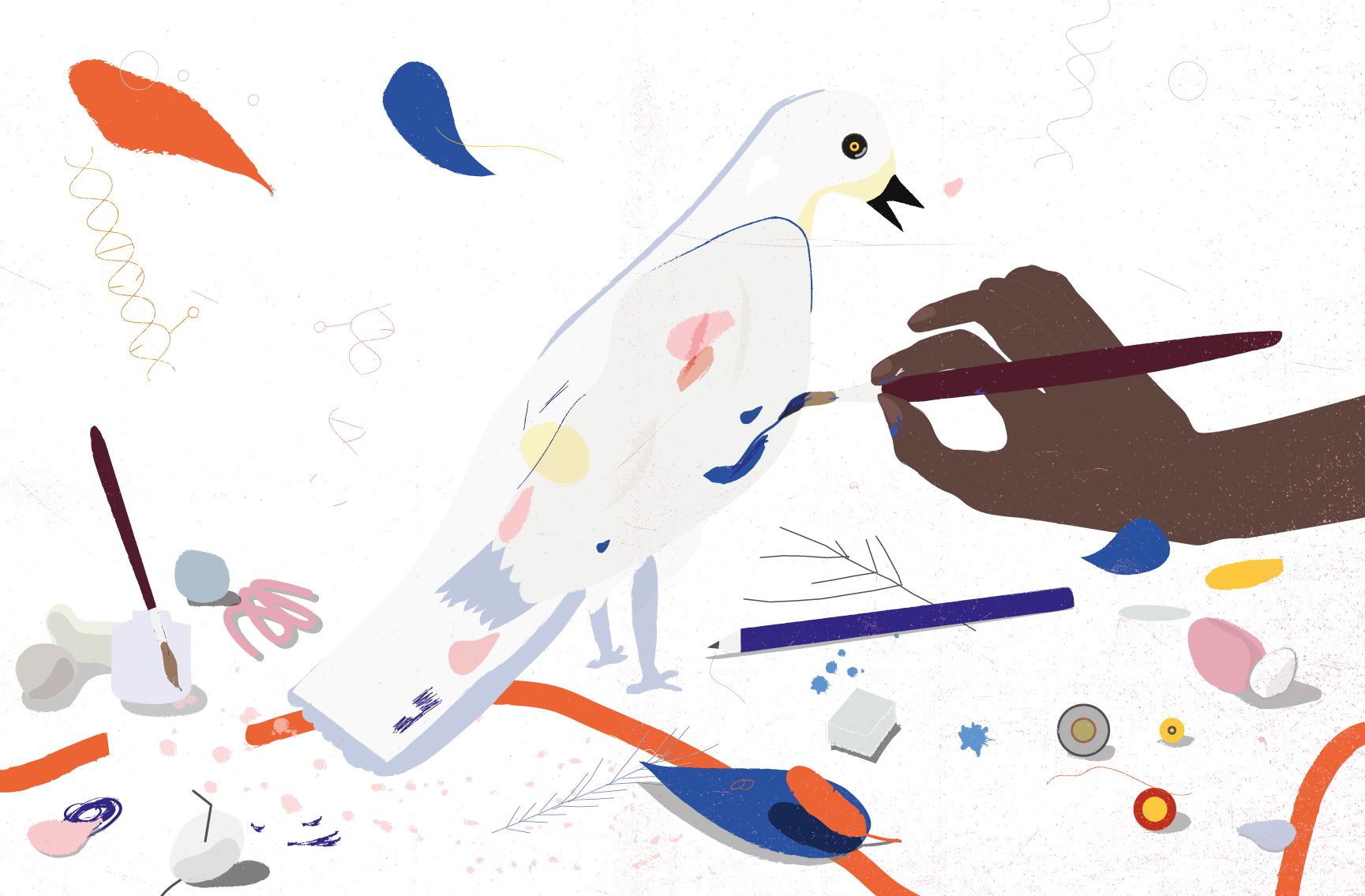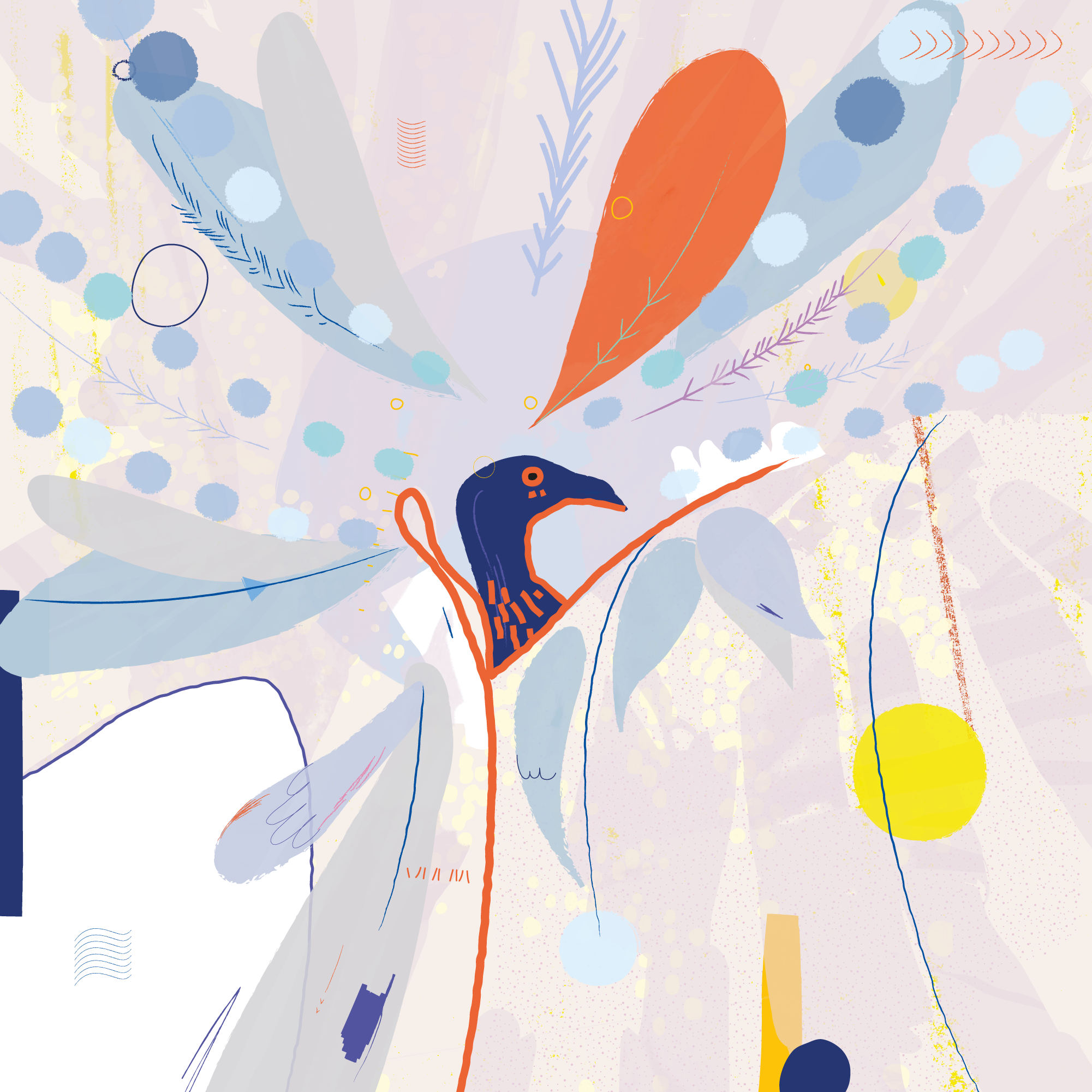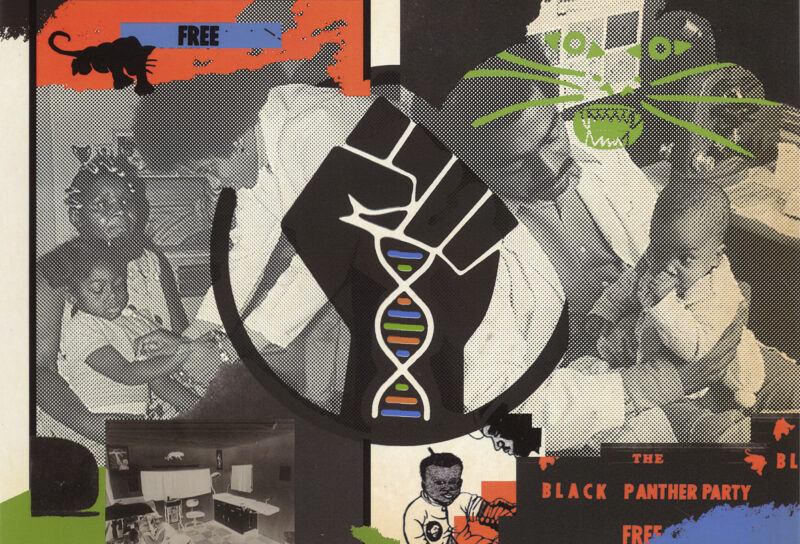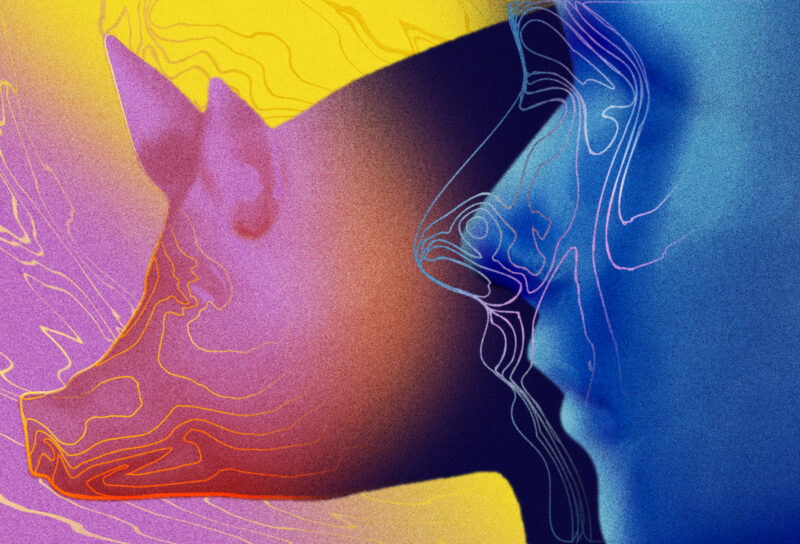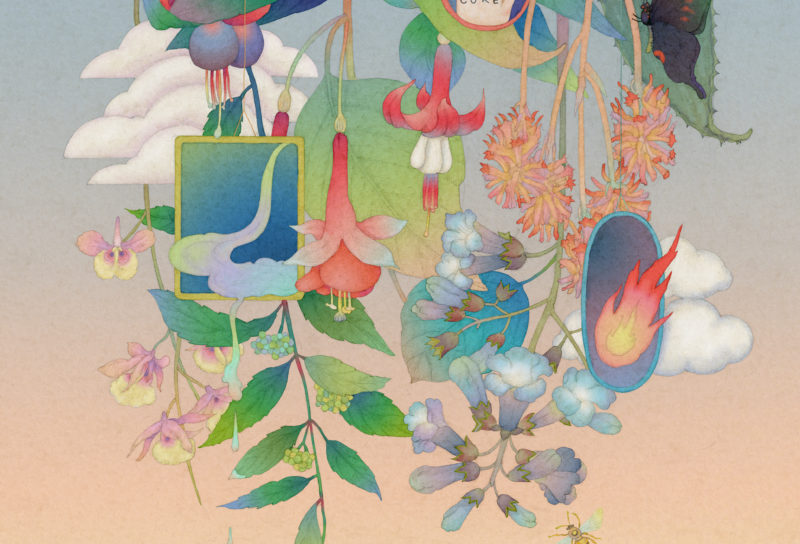Deep in the rainforests of Borneo, Sumatra and the Malay Peninsula lives what some consider to be the most beautiful creature in the world: the male Great Argus pheasant. Going about his daily business, he doesn’t look like much — basically, a very long wild turkey. But when he runs into a possible mate, a quite extraordinary transformation takes place. He suddenly becomes beautiful.
In preparation, he clears a six-yard stage on the forest floor, picking up leaves, twigs and roots with his little white beak, finally beating his wings to blow away the debris. And then his dance begins. Starting off with a neurotic meta-bit, he struts around theatrically, pecking at the clear stage. Then, in the blink of an eye, he twirls out his wings, transforming himself into a dazzlingly large, intricately patterned circle, and starts performing a pheasant version of the fan dance from Madam Butterfly — vibrating, shaking and shimmering for up to 15 seconds at a time. Finally, resuming his old form, he returns to his routine, strutting around, pecking the ground.
The polka dots, washed-out stripes and swirling op-art waves that pattern his wing feathers are gorgeous, and the 300 pale yellow spots radiating over them, absolutely mesmerizing. A complicated trick of the eye is at play here. The spots increase in size as they rise up his wings, creating a forced perspective illusion. To the hen facing him on the dance floor, they all appear the same size, while their delicate color gradients, shaded around the bottom curve and highlighted on the top, conjure the illusion that they’re three-dimensional spheres, bright glowing golden orbs floating there in the heart of the dark rainforest. For the duration of his episode, the Great Argus is a nightclub full of sparklers; a piece of performance art millions of years of evolution in the making; a living Yayoi Kusama installation; at the center of which, peeking out behind his feathers, can be glimpsed his pleading blue, small hopeful face.
How do you evolve into such a spectacle?
Where It Comes From
While 19th-century French poet Charles Baudelaire saw nature as a forest of symbols, colors, lines and sounds connected by mysterious affinities only a poet could decipher, evolutionary biologist Richard O. Prum, author of The Evolution of Beauty (2017), sees it as a chaotic, irrational and endlessly surprising exhibition that can only be understood through Charles Darwin’s lesser-known theory of sexual selection. Prum’s book expounds on the aesthetic mating choices made by animals to explain the human experience of beauty in much of its variety.
“The sight of a peacock’s tail, whenever I gaze at it, makes me sick!” Darwin once ranted. He had reason to be pissed. The peacock’s huge, colorful appendage appeared to undermine much of what he’d claimed in his book On the Origin of Species (1859). The bird’s ornamentation didn’t seem to help it survive in the wild, so it was hard to explain through his theory of natural selection. By 1871, however, he had resolved the contradiction in a follow-up book. In The Descent of Man, he hypothesized that peahens chose peacocks with the most impressive tails, allowing those peacocks to sire the most chicks, which over time would evolve to sport more and more extravagant tails.
Darwin — whose body of work has been critiqued for its inherent white supremacy and sexism — believed that the most outlandish and impractical forms of beauty, like peacock’s tails and Great Argus’s wings, had evolved to be pleasurable for other birds of the same species to observe, and had no other purpose but sexual charm. This was his theory of mate choice. Not only were natural and sexual selection different processes, they operated independently of one another.
Many biologists working after Darwin have adopted more conservative, less sensual interpretations. While few deny that sexual selection takes place, the prevailing counterargument is that ornamentation and displays provide specific, honest information about an animal’s quality and condition; meaning that these features have an objective, rather than a subjective, allure. Beauty is thus a reflection of an animal’s integrity.
For Prum, however, this cannot be. His argument is that while ornamentation may perhaps have been an honest indicator of quality in the beginning, over time that correlation would surely have been lost, leading to ornamentation for ornamentation’s sake. The fact that most animals can choose their own mates from an array of suitors leads to an aesthetically inspired and massively unpredictable evolutionary force: sexual attraction to forms of ornamentation and display in and of themselves.
Beauty is one phenomenon for which we haven’t yet found a satisfactory explanation. Perhaps this is why it has such power
over us.
Prum recalls having lunch at a college one day and describing his ideas about why sexual ornamentation had grown to be so diverse, and so beautiful, to a fellow evolutionary biologist: “Toward the end of the lunch, he cried out, ‘But that’s nihilism!’” Prum’s interpretation seemed horribly bleak to his colleague because, in some sense, it deprives us of any purpose or meaning in our lives. If feathers evolved to be merely beautiful, and pleasing to the eye, rather than to indicate some other more vital quality, it implies that the universe isn’t rational; that we all live in a world of trompe-l’oeil, smoke and mirrors and sensual temptations.
Many biologists would rather we disregard the role beauty plays in evolution, because the very idea of beauty is hard to quantify, let alone justify. Incidentally, a similar discomfort has been present in the realm of art and aesthetics from its very beginning in Ancient Greece. Numerous classical philosophers and scientists have feared beauty’s seductive pleasure, and tried to find arguments with which to explain away its chaotic, hypnotic allure. What both groups seem reluctant to accept, however, is the possibility that there’s no rational explanation for why we find some beings and objects beautiful. Beauty is one phenomenon for which we haven’t yet found a satisfactory explanation. Perhaps this is why it has such power over us.
Somewhere Between Biology and Art
In his “Ode on a Grecian Urn” (1819), John Keats first addresses and finally gives a voice to a classical vase, concluding:
“Thou shalt remain, in midst of other woe
Than ours, a friend to man, to whom thou say’st,
‘Beauty is truth, truth beauty, — that is all
Ye know on earth, and all ye need to know.’”
As his verse alludes to, the Ancient Greeks often conceptualized beauty as representing moral virtues like truth or moderation, or as adhering to mathematical principles, like Pythagorean harmony and symmetry. In the Pythagorean reading, what makes a person beautiful is a robust, beaming complexion reflecting the balanced equilibrium of their four humors (the bodily fluids blood, phlegm, and yellow and black bile, which were once thought to control health) and the harmonious arrangement and proportions of their limbs, which adhered to the same laws thought to govern the distances between planets in the night sky. Everything was to have a rational explanation.
For Prum, however, it’s precisely the unconstrained irrationality of desire that makes nature so beautiful. This is what fills life with boundless freedom and choice. It’s because animals are often free to choose their mates that beauty can evolve into such wonderfully unlikely and wide-ranging forms. The ways in which a bird might become more desirable are so much more open-ended and unpredictable than how it might open a seed. Desire opens up many new possibilities, and seduction is far richer and more mysterious than practicality. Furthermore, features that evolved in the first instance to be beautiful may come to have unexpected new functionalities that have nothing to do with sex. Prum suggests that dinosaurs may have evolved to have feathers as ornaments first, long before those feathers allowed them to fly.
Because they can choose who to mate with, animals are agents in their own evolution. “In the process of choosing what they like,” writes Prum, “choosers evolutionarily transform both the objects of their desires and the form of their own desires. It is a true coevolutionary dance between beauty and desire.” In nature, then, desire and the object of desire co-evolve, spiraling upward in tandem; and the same is true in art.
Since antiquity, artists have pushed the limits of what can be considered beautiful, and what can be considered art, continuously refining their tastes and ours. While animals often evolve in such a way that their inherited traits become more heightened and perfected, artists more often react against the tradition they’ve inherited and try to create something completely different. Over time, however, both processes tend toward the same outcome: many separate and unusual forms of beauty. Sexual autonomy, like artistic autonomy, is an engine of beauty.
Now let’s consider birds’ penises. Some birds have penises, but most, around 95%, do not. Rather than having penetrative sex, they mate through a cloacal kiss. Most birds of both sexes have a cloaca — a chamber inside their anus into which their digestive, urinary and reproductive tracts all flow — and reproduce by touching assholes. The male unloads his sperm and the female accepts it inside her. This process makes forced sexual intercourse a physical near-impossibility, giving females dominant agency in the matter of mate choice. They get to choose who they most want to cloacal kiss, and have the luxury of being picky.
This choice, Prum believes, is what has led some male birds to evolve such striking aesthetic extremes of ornamentation and display. He also believes it’s what has allowed them to evolve such a wide diversity of forms and to flourish so widely: penis-free birds, he notes, are the most successful kind of terrestrial vertebrates in terms of the sheer number and variety of species.
The evolution of beauty in nature is overwhelmingly driven by females choosing the most beautiful males, rather than vice versa; humans, in our enduring fascination with female beauty, are an exception. While art historians and critical theorists have written extensively about the historical dominance of the male gaze, and how it’s perverted our own standards of beauty and contributed to an unrepresentative artistic cannon that prioritizes both heterosexual and homosexual male sexual fantasies, in the natural world it’s more often the female gaze that arbitrates beauty. This is the parochial nature of the human gaze, which rarely considers how the world appears to other beings.
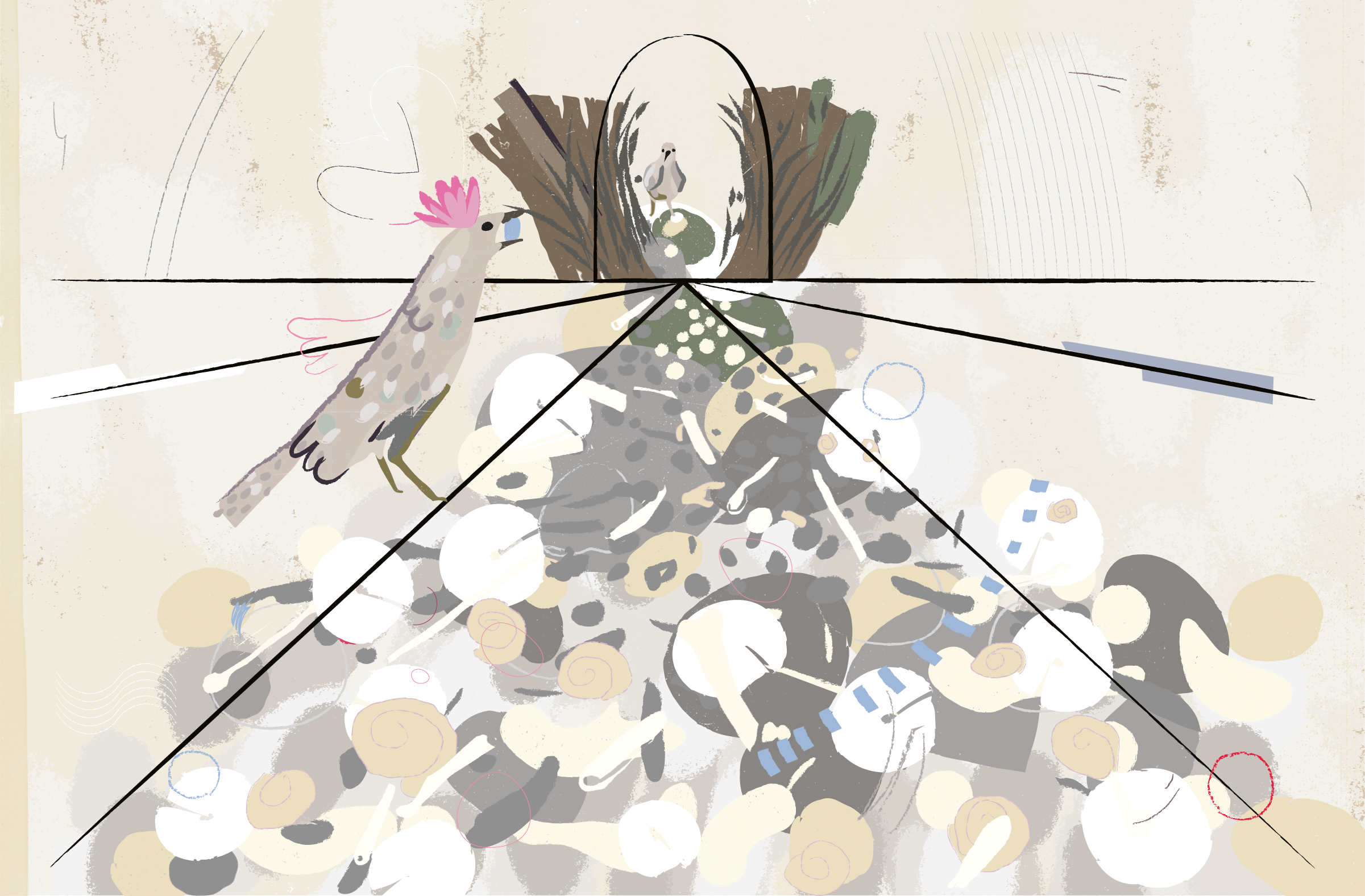
Pre- and Post-Human Art & Design
Contrary to popular opinion, linear perspective wasn’t invented by architects in early-15th century Florence, but by Great Bowerbirds millions of years ago in the dry, open woodlands of Northern Australia. Male bowerbirds create bowers — which is to say, elaborate courtship spaces — in the hopes of attracting a mate. The Great Bowerbird constructs an arched, woven tunnel of branches on the ground, in front of which he lays down a gesso — an avenue of found white bones and pebbles, and sometimes differently colored trinkets — to attract mates.
These objects are arranged in order of size, increasing with distance from the bower, to create a forced perspective illusion that flattens visual space. Viewed from inside of his bower by his visitors, these objects appear fairly uniform in size. In one study, evolutionary ecologist John Endler and his colleagues greatly inconvenienced a bowerbird by reversing the illusion in his bower, rearranging the objects so that they decreased in size and the visual space was deepened rather than flattened. Fortunately, within a few days the male bowerbird had restored order. His bower, after all, is where the magic happens. Subsequent studies by Endler have shown that the more convincing the bowerbird’s use of perspective is, the more sexual success he enjoys.
During the Italian Renaissance, artists used their new-found knowledge of perspective and other optical effects to paint imitations of nature in accordance with these scientific rules, leading to a revival of the Ancient Greek and Roman theory that beauty comes from the proportions of different parts of a body, space or composition, as exemplified in masterpieces that you may now find hanging in an Italian restaurant — by Leonardo da Vinci and Piero della Francesca. No sooner did this become a new standard, however, than other artists looked to challenge it. Novelist and semiotician Umberto Eco, in his History of Beauty (2004), detects a turning point in Northern Renaissance master Albrecht Dürer’s engraving Melencolia I (1514), which he interprets as revealing a new association of geometry and mathematical precision with melancholy; one foreshadowing the coming abandonment of such scientific, highly rational approaches to creating beauty in art.
The Mannerists that came to prominence right after the Renaissance favored flowing, serpentine depictions of figures that could not be so easily inscribed in circles or quadrilaterals as da Vinci’s Vitruvian Man (1490) had been; which is not to say that geometry was abandoned, but rather that it was no longer used as a standard by which to measure objective beauty, and was instead used to produce more complex representations of space, more dramatic angles and perspectives, and more exaggerated, theatrical bodies, overturning previous ideals of harmony. The rise of the critic in the 18th century, Eco writes, allowed for further development and strengthening of this idea that beauty was a matter of subjective taste, and not of objective classical rules. He connects this to 18th-century philosopher David Hume’s understanding of subjectivity: that beauty is not inherent in things, but rather formed in the imagination of the critic or the artist. Likewise, beauty is not inherent in a male bird, but rather formed in the subjectivity of his female beholder; and the subjectivity of taste will lead us down unexpected paths.
Where does art come from? Eco’s story begins with a photograph of a kouros, a sculpture of a naked male figure, from 6th-century B.C. Greece. It comes, in the first instance, from representations of ourselves. Art, for Plato, was the imitation of life, of nature. At many different points in its history, however, our understanding of artistic beauty has become decoupled from past ideals such as realism or harmony, leading to more expressive, more unusual and provocative approaches. In the same way that Mannerist painters abandoned geometrically precise realism in favor of curving, elongated and exaggerated silhouettes, the Great Argus might also be interpreted as a preposterously flamboyant, over-evolved and Mannerist bird. Its existence pushes at the seams of possibility. In the brief effervescence of its displays, perspectival illusion is used to warp the viewer’s perception of what a body looks like, and confuse and dazzle them, just as the Mannerists liked to.
Birds, like art, can grow decadent. Attraction is an irrational process and can lead to irrational outcomes. Sexual selection occasionally results in massively elaborate forms of ornamentation and display, which means that animals can evolve in ways that are maladaptive and make it harder for them to survive. In fact, the world’s most absurdly beautiful animals are probably so rare exactly because they’re beautiful.
Beauty in nature is mostly meaningless and arbitrary and, in Prum’s telling, this is what allows it to be so diverse and so bafflingly, improbably spectacular. Likewise, in art and culture, there’s no longer a single model of beauty, or anything close, and Eco ends his book with a celebration of “the orgy of tolerance, the total syncretism and the absolute and unstoppable polytheism of Beauty.” In both cases, beauty continues to find new and unexpected forms because of how desire and the object of desire co-evolve harmoniously and how, the more choice one has, the more extreme the forms that arise in turn become.
We humans are often thought to be sui generis, unique beings because of our ability to appreciate beauty. But the human art world, Prum concludes, is just one of many “biotic artworlds” that have evolved to suit different animals’ aesthetic sensibilities. “Bird songs, sexual displays, animal-pollinated flowers, fruits, and so on are art, too,” he writes. “They are biotic arts that have emerged within myriad biotic artworlds, each of them a community that fostered the coevolution of animal aesthetic traits and preferences over time.” In other words, all of nature might be considered a post-human artworld.
This vast polytheism of beauty also brings exciting consequences for the field of synthetic biology, in which living things themselves can become a canvas for human expression. As we’ve seen, both natural beauty and art have evolved according to similar processes; but biotech, which likes to think of itself as the next step in evolution, may allow for natural beauty to be set free from sexual selection, and to be created by humans in the same way that art is, allowing for a new synthesis of the human and post-human artworlds. This is as unnerving as it is exciting. Could it change how we think about beauty altogether? Or will it just serve as a new way to reproduce our existing predilections, biases and neuroses?
In his 2013 Princeton University graduation speech, former Federal Reserve chairman Ben Bernanke gave the students some bad advice: “Remember that physical beauty is evolution’s way of assuring us that the other person doesn’t have too many intestinal parasites.” In truth, however, studies have shown no proof of correlation between good genes and sexual preferences. There’s no value signifier encoded into sexual attractiveness, and beautiful people are in no way superior to ugly people; as you’ll have noticed, if you’ve spent time with beautiful people.
Human attraction, furthermore, has to do with so much more than physical beauty. It takes a wide variety of forms, most of which cannot be sensed through a picture on a screen. The way we date now, by swiping left or right on our phones, is deeply unsuited to how we’ve evolved to fall in love. Our highly developed society has led us to develop intricate social qualities such as a good sense of humor, thoughtfulness, self-expression, kindness, and so forth, which also play a large role in attraction and may well have evolved precisely because they help with the formation of enduring relationships. “Falling in love,” writes Prum, “has become more and more elaborate, not to mention emotionally intense, enjoyable, and potentially heartbreaking, because it is the result of a coevolutionary process — millions of years of aesthetic, mutual mate choice.” What really makes us sui generis, he contends, is not our ability to appreciate beauty, but rather our ability to fall in love. That is unique to humans among all animals. We are fanciful.
This is the introductory essay of Grow’s second annual print issue. To read more pieces like it, order our Beauty Issue now.
